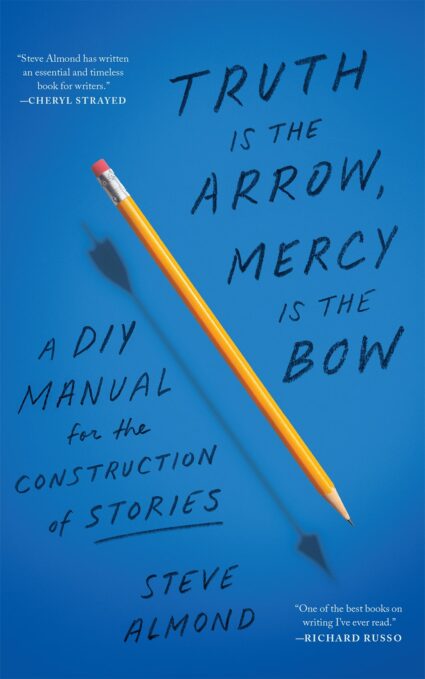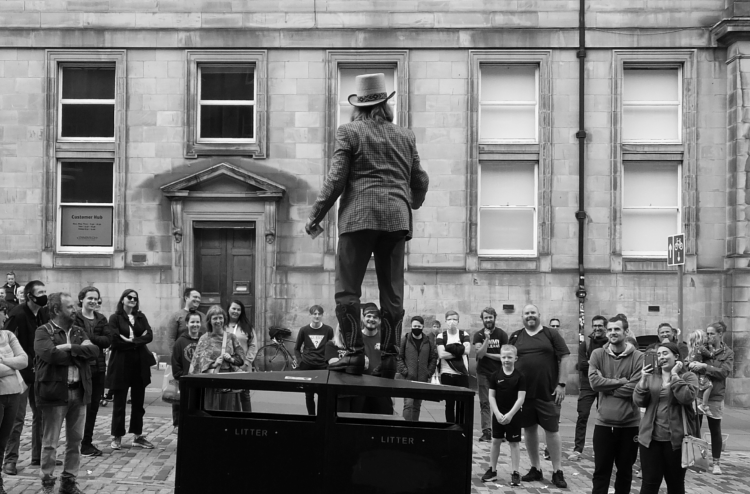Steve Almond has lived many lives in pursuit of his most elusive dream: publishing a novel. He’s been an investigative journalist, tortured poet and author. Before he published “All the Secrets of the World” in 2022, he worked on five fiction manuscripts that did not find a public audience. For 30 years, he has published works of fiction and non-fiction and taught writing. He currently teaches narrative non-fiction writing at the Nieman Foundation at Harvard University, a course I attended as a 2023 Nieman Fellow.
The results of his efforts are described in his latest book, “Truth Is The Arrow, Mercy Is The Bow: A DIY Manual for the Construction of Stories.”

In it, Almond tackles many topics. Some are standard (character development, chronology). Others feel distinctly Almond (sex scenes, creative entitlement). Punctuated throughout are Almond’s experiences as a son, brother and father. While he draws from other writers, Almond takes almost masochistic delight in plumbing the depths of his own failures to illustrate different points about writing and creative decision making. Perhaps it’s his way of redeeming himself. And he understands that writing is an act of subjectivity: He wants to be honest about how he’s made his way.
When I asked Almond, after publishing his book, if he likes talking about his failures, he said he prefers it to “tooting his own horn.”
“I’m not interested in the social media posts that are like, ‘Look at this beautiful sunset. Look at this beautiful family. I finished my book. I got a big award.’ I personally can’t really participate in that other than by being envious or skeptical,” he told me. “But if somebody tells me they’re struggling or they screwed something up or they’re feeling doubt or uncertainty, I can participate in that all day.”
While Almond offers tips for all kinds of writers, here is his most useful advice for journalists and writers of narrative non-fiction, gleaned from his book and our conversation.
Drop the performance
Vanity is often the root cause of the ailments that afflict creatives, whether that’s writer’s block, overwrought metaphors or run-on sentences.
“All bad decisions at the keyboard arise from insecurity,” Almond writes in “Truth Is The Arrow.”
When self-doubt creeps in, writers begin making decisions to soothe their ego rather than to serve the story. Instead of having a crystal-clear idea of whom they are writing about, what motivates them, what sabotages them and if they can be redeemed, writers shackled by insecurity wind up overthinking their position in the universe of other writers. Almond writes that they become mired in self-serving questions like ‘Will this metaphor impress the reader? Am I smart enough to pull this off? Funny enough? Deep enough?’
When you begin performing for the reader, or other writers, the story suffers. And when you publish, the universe of writers escalates in noise but it doesn’t gain dimension.
There is much to gain when you drop the facade of “Serious Investigative Journalist” or “Great Chronicler Of The Human Condition.” Instead of miming other writers, you can become something no one else can fully ape: yourself.

“Voice is what emerges when you stop performing,” writes Almond. It’s “when your voice on the page flows from your voice off the page, its particular rhythms and vernacular and sensibility.”
Ideas, too, flow when you aren’t trying to mirror the work of others.
When you catch yourself preoccupied by what kind of article or book you should be writing, Almond writes that a more useful question to ask is What kind of article or book do I want to write?
Real curiosity and excitement lead to better questions, deeper inquiry and a richer story.
Own your writing decisions
In the Q&A section of his book, Almond admits he avoids telling people he is a writer. He prefers focusing instead on what he does. To that end, the term “word decider” feels more appropriate to him.
Almond’s preferred title underscores the fact that everything that shows up on the page or the screen is a personal choice made by the writer.
“Writing is decision-making,” he says in his book. “What word? Where to place the comma? How to shape the paragraph? Which characters to undress and in what manner? It’s relentless.”
Take chronology, for example. In his chapter on chronology, Almond poses two crucial and related questions for writers:
- Where, in the larger flow of events, have I chosen to enter the story?
- How did my central character arrive at this moment, and what’s at stake for her?
The same is true for characterization. Whether it’s indirect or direct, the facts we include in the description of a character, their life and their actions is a choice.
Almond goes even further, at one point, to say that storytelling is an act of seizure. When you write, you seize the right to share with the world your version of something that took place.
So make your writing decisions with intention. Whether you’ve decided to start a story with a childhood memory of the main character, or you’ve decided to include a description of how she styles her hair, it should be done with a purpose that feels obvious to the reader.
If you’re the one driving the story bus, set a course for an unforgettable destination, and invite the reader to join you by sharing the route you’re taking.
Tap into mercy
Most journalists and non-fiction writers can develop the skills to address the who, what, when, and where of a story. But often the trickiest question to answer is “Why?”
Answering the “why” of a story requires us to locate the motives of people we may not know or like.
It’s common to hear calls for empathy in journalism, which Lauren Kessler described in Nieman Storyboard in 2022, as “the ongoing challenge to try to understand another person’s point of view.”
But the word “empathy” only makes one appearance in Almond’s book. To him, the engine that powers understanding others is love. Love is expressed through writing when writers tap into mercy — to not just attempt to understand why someone acts a certain way, but to avoid issuing a verdict.
Almond is quick to clarify that writing mercifully doesn’t mean that you can’t arbitrate the truth of what someone has said. It also doesn’t mean that you grant your subjects moral absolution.
“Mercy is the bow and truth is the arrow,” Almond told me, echoing his book’s title. “Your intention is to travel as far into the truth as you can, which requires withholding judgment.
“That’s the best kind of journalism people can do,” he said. “It’s not designed to agitate or provoke or dig you deeper into whatever your dogma is. It’s actually supposed to morally complicate your worldview and make you feel like the person next to you has a rich, complex inner life that has something to do with yours.”
Documenting the lives of your subjects requires a commitment to telling the truth about them, Almond writes. And, he asks, “Is (your) compulsion to tell the truth stronger than (your) fear of the consequences?”
Telling the truth mercifully might require you to spend time understanding a person your readers disdain. In his book, Almond shares one of his favorite stories of how the novelist Claire Messud responded to a critic of her work. At the center of her 2014 novel, “The Woman Upstairs,” Messud constructed a bitter and furious protagonist named Nora. When Messud was asked by a critic if she would want to be friends with Nora, Messud dismissed the idea outright.
“If you’re reading to find friends, you’re in deep trouble,” Messud said. “We read to find life, in all its possibilities. The relevant question isn’t ‘Is this a potential friend for me?’ But ‘Is this character alive?’”
Messud’s story is a reminder, Almond writes, that your job isn’t to coddle your subjects or to present them in the most flattering light. It is to “witness and interrogate” who they are and what they do. Only then can you understand the “why” at the heart of their story.
* * *
Ruth Tam is a writer, illustrator and podcast host. A 2023 Nieman Fellow, her work has been published by NPR, The Washington Post and The New Yorker.



